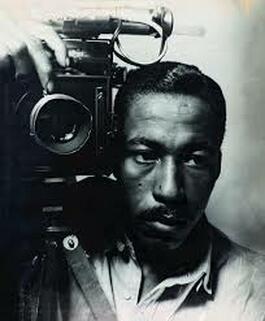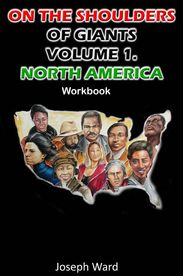|
On November 30, 1912, Gordon Rodger Alexander Buchanan Parks was born in Fort Scott, Kansas, to parents Andrew Jackson Parks and Sarah Ross. Andrew Jackson Parks was a farmer who supported his family though they lived in humble conditions; Gordon Parks was the youngest of his parent’s fifteen children. The Jim Crow laws ruled America at the time so Gordon and his family faced racism on a regular basis. As a child he attended segregated schools which denied black students the opportunity to play sports and attend school functions. The white teachers often tried to discourage the black students from going to college or pursuing professions that was outside of serving servitude. At the age of eleven, Parks was assaulted and threw into the Marmaton River by three white boys, they knew he couldn’t swim and hoped he drowned. Gordon had the presence of mind to use the water to screen himself from the white boys and make it safely to land. Gordon’s mother Sarah Ross died when he was fourteen years old, twelve months later Gordon went to live with his sister named Maggie Lee and her husband in Minneapolis -Saint Paul, Minnesota. Maggie Lee’s husband was not fond of Gordon living with them and later kicked him out of their home. Gordon was forced to make a living for himself as a fifteen year old in a Jim Crow America; he did enroll himself into Central High School to further his education, but later dropped out to make a living for himself. He worked a number of jobs to help himself such as, working in a brothel, working as a bus boy, a piano player, water, semi-pro sports, and other odd jobs. Parks could write music and was overheard playing one of his songs on a piano by a Jazz band leader, the two became acquainted and the Jazz band was performing Parks’ song on the radio, shortly after Parks was a singer in the band. In 1933, Parks married his first wife Sally Alvis and supported his family as a singer in the Jazz band. Parks’ time with the band did not last long as it disbanded in New York City, Parks needed to be able to support his family so he begin working with the New Deal Civilian Conservation Corps clearing forest land in New Jersey. Parks and his family eventually moved back to in Minneapolis -Saint Paul, Minnesota and Parks begin working on the Northern Pacific Railroad as a train porter in 1937. While working on the Northern Pacific Railroad trains, he would see magazines that were filled with photographs of migrant workers and was inspired to become a photographer. He was twenty-five years old when he brought his first camera and began teaching himself to become a professional photographer. From the beginning, Parks had a gift for photography; during the development of his first roll of film he was praised for his work and encouraged to look for photography work at a women’s clothing store. Marva Louis, the wife of legendary boxer Joe Louis was blown away by Parks’ work and pushed for Parks and his wife to move to Chicago to further his career. In 1940, Parks begin his photography business in Chicago, which at the time specialized in photographs of notable women. Along with photographing notable women, Parks had a keen eye for capturing the black American experience; this led him to receiving the Julius Rosenwald Fellowship in 1941. The fellowship paid him two-hundred dollars a month and he was able to choose his employer. He was later asked to join the Farm Security Administration and help them capture the true conditions of America and its people; the project was led by a man named Roy Stryker. Parks and his family lived on the South Side of Chicago; his work as a freelance photographer helped him gain the Farm Security Administration fellowship. Parks gained recognition for his legendary photograph titled American Gothic, Washington, D.C., which was a black adaptation of the American Gothic painting by Grant Wood of the white farmer and his wife. Parks’ photograph depicted a black woman named Ella Watson who worked as a janitor for the Farm Security Administration. The photograph is showing Ella Watson standing in front of the American flag, holding a broom in her right hand, with a mop in the background behind her left shoulder. The photograph was showing the segregation and racism that was very prevalent in America. The Farm Security Administration eventually disbanded while Parks was in Washington D.C., because of the opportunities he remained in Washington D.C. and became a photographer for the Office of War Information, photographing the all-black 332nd Fighter Group. Parks and Roy Stryker connected again and Parks became the photographer for the Standard Oil Photography Project located in New Jersey. Parks’ most memorable photos were Dinner Time at Mr. Hercules Brown's Home, Somerville, Maine, Grease Plant Worker, Pittsburgh, Pennsylvania, Car Loaded with Furniture on Highway, Self Portrait, and Ferry Commuters, Staten Island, N.Y. In 1948, Parks was able to publish his first photo essay in Life Magazine, making him the first African-American photographer for Life magazine. Parks noticed that Life’s descriptions of his photos did not describe what he was photographing so he insisted on writing the descriptions for his photos. From 1950 to 1951, Parks was working in Paris for Life Magazine’s Paris bureau after showing his adaptability as a photographer to Wilson Hicks, the editor of Life magazine at the time. He was able to move throughout Europe photographing people from all walks of life. Back in America, Parks was able to capture pictures of the Civil Rights movement and black leaders from Malcolm X to Stokely Charmichael. His talent was on full display around the world and was capturing photos of many well-known artist and celebrities. Parks also worked in the film industry as a director and consultant; some of his movies include The Learning Tree, Shaft, Shaft's Big Score, a biopic of the blues musician Huddie Ledbetter, and a number of other films. Parks was an ultra-talented person; he published fifteen books and even dabbled as a painter. He died in 2006 as a result of liver cancer, leaving behind a long list of works that changed the Photography industry, the world of art and, inspired generations of artist. He and his first wife Sally Alvis divorced in 1961, he then married Elizabeth Campbell in 1962, the couple divorced in 1973 before he married his third wife Genevieve Young. Parks was an amazing man with a great eye to be able to capture the true existence of black America through his photography. He was an artist that other artist admired, he used his talents to show what was really happening to black Americans and the people considered the upper echelon of their society. He believed in himself despite being told he was only good enough to serve white people, when he was a child. Mr. Gordon Rodger Alexander Buchanan Parks, we proudly stand on your shoulders. J.A. Ward Click here to learn more about the On the Shoulders of Giants book series!!! References:
https://www.notablebiographies.com/newsmakers2/2007-Li-Pr/Parks-Gordon.html https://en.wikipedia.org/wiki/Gordon_Parks https://www.theartstory.org/artist-parks-gordon-life-and-legacy.htm https://www.biography.com/people/gordon-parks-37379
0 Comments
Leave a Reply. |
Details
Categories
All
Click Here to join our mailing list
|
Contact Us: |
Connect With Us |
Site powered by PIT Web Design


 RSS Feed
RSS Feed



